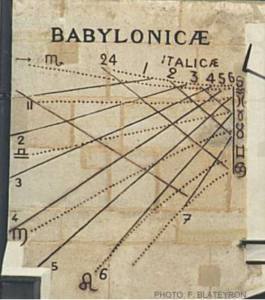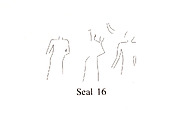

There is no problem understanding what the Yale tablet YBC 7289 is about. As a final comment on what these four tablets tell us of Babylonian mathematics we must be careful to realise that almost all of the mathematical achievements of the Babylonians, even if they were all recorded on clay tablets, will have been lost and even if these four may be seen as especially important among those surviving they may not represent the best of Babylonian mathematics. Conversely we must be careful not to underestimate the significance of the mathematics just because it has been produced by mathematicians who thought very differently from today's mathematicians. Firstly we should be careful not to read into early mathematics ideas which we can see clearly today yet which were never in the mind of the author. The particular tablet which concerns us is not one relating to administration but one which presents a geometrical problem which asks for the dimensions of a rectangle whose area and diagonal are known.īefore looking at the mathematics contained in these four tablets we should say a little about their significance in understanding the scope of Babylonian mathematics. Most relate to the administration of an ancient city which flourished in the time of Ibalpiel II of Eshunna and date from around 1750.
#1988 in babylonian numerals how to
The particular tablet which interests us here investigates how to calculate the radius of a circle through the vertices of an isosceles triangle.įinally the Tell Dhibayi tablet was one of about 500 tablets found near Baghdad by archaeologists in 1962. W K Loftus identified this as an important archaeological site as early as 1850 but excavations were not carried out until much later. The town is about 350 km from the ancient city of Babylon. The Susa tablet was discovered at the present town of Shush in the Khuzistan region of Iran.


However in Neugebauer and Sachs gave a new interpretation and since then it has been the subject of a huge amount of interest. It is thought to be only part of a larger tablet, the remainder of which has been destroyed, and at first it was thought, as many such tablets are, to be a record of commercial transactions. Its date is not known accurately but it is put at between 1800 BC and 1650 BC. You can see from the picture that the top left hand corner of the tablet is damaged as and there is a large chip out of the tablet around the middle of the right hand side. Plimpton 322 is the tablet numbered 322 in the collection of G A Plimpton housed in Columbia University. The tablet and its significance was first discussed in and recently in. The diagram is a square of side 30 with the diagonals drawn in. It consists of a tablet on which a diagram appears. The Yale tablet YBC 7289 which we describe is one of a large collection of tablets held in the Yale Babylonian collection of Yale University. Let us say a little about these tablets before describing the mathematics which they contain. The four tablets which interest us here we will call the Yale tablet YBC 7289, Plimpton 322 (shown below ), the Susa tablet, and the Tell Dhibayi tablet. The article Babylonian mathematics gives some background to how the civilisation came about and the mathematical background which they inherited. Here is a map of the region where the Babylonian civilisation flourished. What times what shall I take in order to get 9 ?Īll the tablets we wish to consider in detail come from roughly the same period, namely that of the Old Babylonian Empire which flourished in Mesopotamia between 1900 BC and 1600 BC. A translation of a Babylonian tablet which is preserved in the British museum goes as follows:-Ĥ is the length and 5 the diagonal. Certainly the Babylonians were familiar with Pythagoras's theorem. Pythagoras's theorem in Babylonian mathematics In this article we examine four Babylonian tablets which all have some connection with Pythagoras's theorem.


 0 kommentar(er)
0 kommentar(er)
